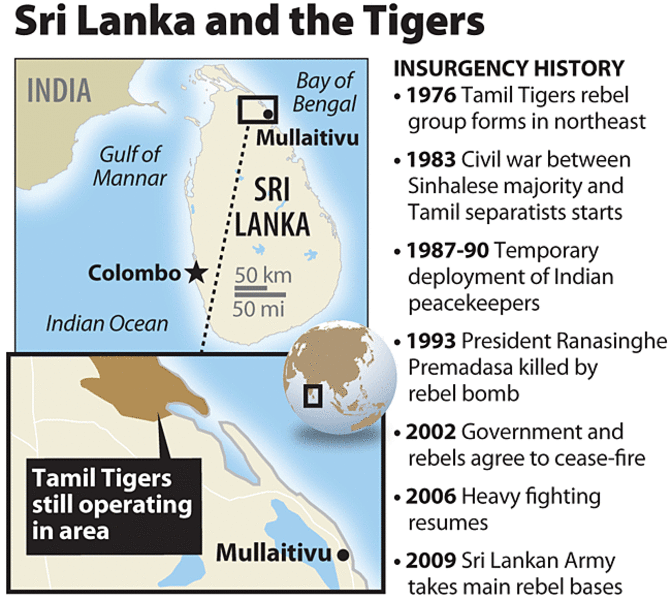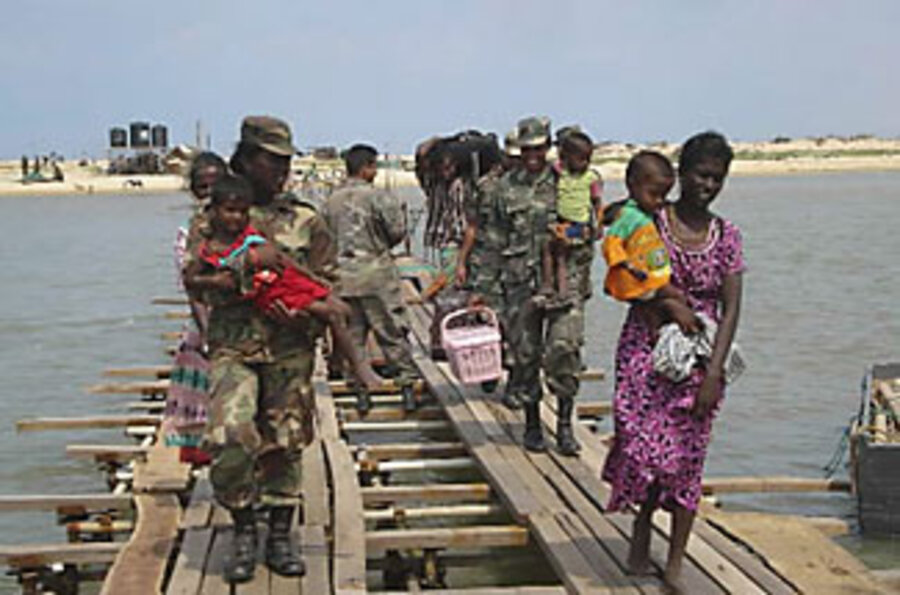Sri Lankan civilians trapped by Tamil Tigers 'last stand'
Loading...
| Putumattalan, Sri Lanka
On the far shore of a brackish lagoon, white Brahmin cows stoop to drink. Behind them, over a muddy embankment, palm trees frame a row of abandoned shelters on a sandy beach. Just two weeks ago, this was a Tamil Tiger stronghold.
A few miles south, hundreds of Tamil rebels are making a final, desperate stand in Sri Lanka's 26-year civil war. Held there, as pawns in the military endgame, are tens of thousands of ethnic-Tamil civilians. Short on food and water, and pounded by artillery shells, their plight has triggered international concern but no halt in the fighting.
Instead, a final assault seems imminent. On Apr. 30, one day after rejecting calls by British and French envoys for a cease-fire, President Mahinda Rajapaksa said in a speech that the Liberation Tigers of Tamil Eelam (LTTE) had five or six days left to surrender.
Similar deadlines have come and gone before. But an aid worker in Vavuniya, where refugee camps are overflowing with newcomers from the war zone, says military officials had told her last week to expect another 50,000 arrivals by midweek. That number is at the low end of the UN's estimate of remaining civilians trapped by the two warring sides.
Army commanders leading a tightly scripted media tour of recently captured areas gave a more cautious assessment. Victory would be in "a couple of weeks, at the most," General Jagath Dias told reporters.
World's 'largest hostage rescue mission?'
As the fighting has shrunk to a narrow strip of rebel-held land, currently less than three square miles, Sri Lanka's military has framed its offensive against the LTTE as the world's "largest hostage rescue mission." On Friday, it air-dropped leaflets into the area that urged Tamil civilians to seek sanctuary in the cleared areas.
That's what happened here on Apr. 20. Overnight, Army commandos crossed the shallow lagoon and captured the LTTE's defensive embankment. The next morning, watched by spy drones, huge crowds of ragged men, women and children streamed out on foot. By 10 a.m., 5,000 had crossed into government-held territory. At 10 p.m., the number rose to 35,000, in addition to those who escaped north along the sands. In total, 115,000 civilians escaped this way, the military says.
Commanders say that if they can penetrate the final LTTE redoubt, the remainder of the trapped civilians can flee, leaving the rebels to surrender or die. More than 3,000 have surrendered so far. The military insists that no bystanders are harmed in the rescue efforts. "We continue this operation with the aim of not causing any casualties to civilians," Gen. Dias said.
A recent internal UN report, however, estimates that nearly 6,500 civilians had died in the war zone prior to the Apr. 20 outflow. On Saturday, medical officials in the LTTE-held area told the BBC and other news agencies that scores had died during two days of government shelling that hit a makeshift hospital. The government denied the claim.
War crimes by both sides?
It has also pushed back against leaked UN satellite data that appeared to show recent aerial bombardment of civilian areas. The release of the satellite images, which Sri Lankan officials say are inconclusive, appear to be part of an internal UN row over how far to expose what some UN officials are calling war crimes by both sides.
Human rights groups and other observers warn that any final offensive would spell disaster for those caught in the crossfire. A repeat of the Apr. 20 exodus is complicated by the area's topography and the ruthlessness of the LTTE, which is killing anyone caught escaping by boat or land, says another aid worker in direct contact with civilians there.
Ramani Hariharan, a retired Army colonel who was an intelligence chief during India's 1987-1990 peacekeeping operation in Sri Lanka, says it would be almost impossible to distinguish civilians from fighters in the densely packed area. "It's not a neat operation. It's going to be messy. Messy operations lead to casualties," he says.
Dire conditions for trapped civilians
In the war zone, conditions are increasingly dire as thousands of families huddle in trenches in fear of incoming shells. Most only eat one in three days, says the second aid worker. Last week, the International Committee of the Red Cross (ICRC), the only foreign relief agency present, delivered by boat 30 tons of food aid, the first to arrive since early April.
"The fighting is going on. The food is arriving. Do you leave your trench to get food for your family? Do you take the risk? These are tough choices," says Sophie Romanens, a spokesperson for the ICRC.
On the road to the town of Putumattalan, the war's toll is writ large in the empty, burnt-out villages ringed by fallow fields. Only military patrols and distant explosions break the silence of a land seemingly scoured of humanity. Near the front line a line of red buses await the next exodus of war refugees. Since Thursday, none have come out.
Outside a makeshift clinic, Army Private P.O. Athula recalls fierce fire fights for control of this area. Many of the LTTE combatants are children, he says. Three out of four are young women, he estimates. If possible, he says it's better to capture and try to rehabilitate these fighters, who are forced to join the LTTE. "If they are children," he says, "I try not to kill them."






